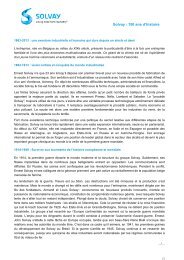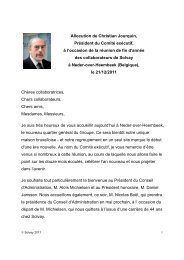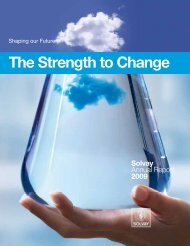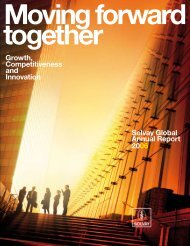solvay_live243_p02a04 somEdito
solvay_live243_p02a04 somEdito
solvay_live243_p02a04 somEdito
Create successful ePaper yourself
Turn your PDF publications into a flip-book with our unique Google optimized e-Paper software.
Dossier SolvayInnovationTrophy2006<br />
NAFTA FACTORING<br />
FACTORING MAKES<br />
NORTH AMERICA<br />
ITS FIRST EXPORT MARKET<br />
When a formula works, why not apply it<br />
elsewhere?<br />
This logic is partly what triggered CICC, the<br />
internal bank and centraliser of the Group’s<br />
commercial flows, to set up factoring<br />
management in the USA (NAFTA region)<br />
now that it has proven its value for the Group’s<br />
European subsidiaries.<br />
Factoring consists of centralising all the financial<br />
movements linked to the commercial activity:<br />
follow through of invoices, cashing of<br />
payments, risk management. Up to date, each<br />
American, Canadian or Mexican company of the<br />
Group managed these aspects of the customer<br />
relationships separately. The project sets out to<br />
centralise this activity in Houston (USA) for all<br />
the subsidiaries of the NAFTA region.<br />
At the service of the SBUs, which thus gain a<br />
competitive edge, centralised factoring will<br />
make it possible to get to know the customers<br />
better, to manage the consolidated positions,<br />
to reduce the commercial risk, to optimise the<br />
working capital, while reducing the processing<br />
costs and ensuring a simpler and therefore less<br />
expensive maintenance of the systems. The<br />
amounts in circulation are quite considerable:<br />
two billion dollars of turnover on which we can<br />
reduce the late payments and accelerate<br />
the financial flows: it is a winning solution that<br />
the CICC is soon set to export to Asia as well.<br />
> Jean-François Caillol; Anne-Marie Bruylants;<br />
Edgar Case; Heather Haidik.<br />
> BSC CICC<br />
72<br />
104985<br />
105235<br />
ESSENTIALITY OF CHEMICALS<br />
CHEMICALS AT THE HEART<br />
OF OUR LIFE<br />
The “Essentiality of Chemicals” project<br />
is a new way of promoting the social<br />
and economic value of our “essential products”<br />
portfolio. This is pursuit through the<br />
organisation of « all in one » events: scientific<br />
debates, events underlining the advantages but<br />
also the limits of the progress of technology via<br />
original initiatives around a long-term dialogue<br />
with representatives of the academic, scientific<br />
and public world, NGO, consumer associations<br />
or the press. This new method of dialogue,<br />
which sets out to be authentic and constructive,<br />
has already taken the form of a symposium,<br />
bringing together in Milan (Italy)<br />
representatives of the authorities, the university<br />
and the press, or visits of the innovative<br />
activities developed in our sites, or even<br />
training workshops for non specialists about<br />
the basic notions of toxicology.<br />
Although essential for our quality of life, our<br />
health, our food, as well as for the role it plays<br />
at the heart of a significant socio-economic<br />
activity, chemistry is nevertheless mistrusted, as<br />
it is misunderstood. A considerable challenge<br />
consists on facilitating the access to the<br />
scientific data necessary for the accurate<br />
understanding of the subject. Certain people<br />
and entities we contacted have accepted to<br />
take up the challenge by contributing, together<br />
with Solvay, to the creation of the independent<br />
NGO GreenFacts (www.greenfacts.org).<br />
The latter publishes, in several languages<br />
and, above all, in a layman’s language, the<br />
summaries of the most recognised international<br />
reports in the field of health and environment<br />
which often involve chemistry related issues.<br />
> Giuseppe Malinverno; Jacques de Gerlache;<br />
Fabio Novelli.<br />
> CC COM & PA<br />
101509<br />
EROSION FREE DISTRIBUTION FOR<br />
OXYCHLORINATION REACTORS<br />
A NEW LOOK<br />
AT AN OLD PROBLEM<br />
The oxychlorination reactors used in the<br />
VCM production process are traditionally<br />
equipped with metallic nozzles that operate<br />
in extreme conditions and suffer<br />
considerably from the effects of erosion.<br />
They are given a lifetime of two years,<br />
during which they undergo a degradation<br />
process that leads to a reduction in efficiency.<br />
Rheinberg (Germany) wanted to put a stop<br />
to this situation and launched a creative<br />
project with an external company and the<br />
local University. Together, they designed new<br />
nozzles. In practice, problems arose with the<br />
fixing of these nozzles onto the reactor grid,<br />
which had to be solved. As the results were<br />
excellent (2003), Tavaux/France, then<br />
Jemeppe/Belgium (2005) adopted the new<br />
design, after making a few modifications.<br />
The nozzles perfectly play their role in the<br />
continuous distribution of the reagents<br />
at the heart of the process and have thus<br />
increased the yield of the VCM units. Their<br />
development has continued on the new<br />
oxychlorination lines in Santo Andre (Brazil)<br />
and Zandvliet (Belgium). This innovation,<br />
whose advantages are very tangible in terms<br />
of maintenance and process optimization, is<br />
today considered as a Solvay standard.<br />
> Frank Vanrompuy; Anne-France Berger; Paul Degraeve;<br />
Bernhard Hogenkamp; Patrick Joubert; Daniel Kinet;<br />
Luigi Mestrone; Jean-Bernard Savoye; Norbert Schmitz;<br />
Heinz-Theo Temath; Wolfgang Ziebarth.<br />
> SBU VINYLS


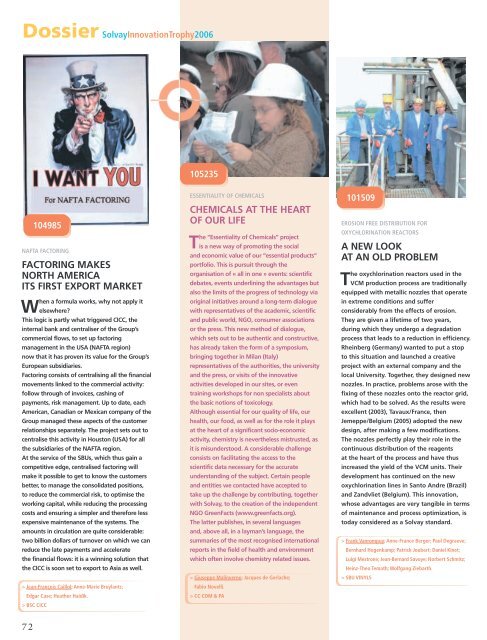

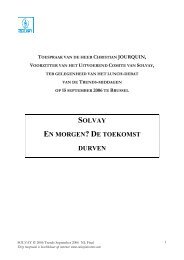
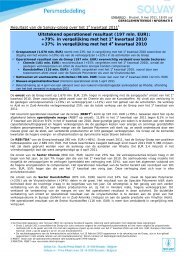

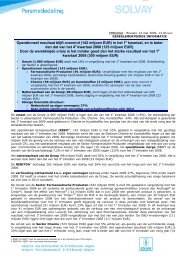


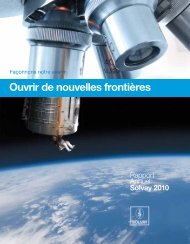
![PROC.1 [LETTRE] - Solvay](https://img.yumpu.com/16585746/1/184x260/proc1-lettre-solvay.jpg?quality=85)
